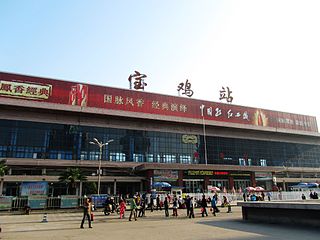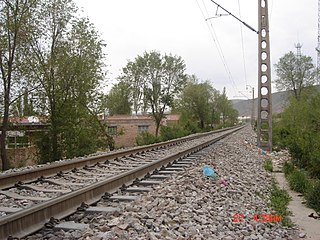
Baoji is a prefecture-level city in western Shaanxi province, People's Republic of China. Since the early 1990s, Baoji has been the second largest city in Shaanxi.

Fufeng County is a county under the administration of the prefecture-level city of Baoji, in the west-central part of Shaanxi Province, China. The county lies in the fertile Guanzhong Plain on the north bank of the Wei River between Xi'an, 110 km (68 mi) to the east, and Baoji, 95 km (59 mi) to the west. It has a land area of 751 km2 (290 sq mi), and a population of 450,000 as of 2021.

The Longhai railway, formerly romanized as the Lunghai railway, is a major arterial east–west railway in China. It runs from Lianyungang, Jiangsu, on the Yellow Sea to Lanzhou, Gansu, through the provinces of Jiangsu, Anhui, Henan, Shaanxi, and Gansu, covering a total length of 1,759 kilometres (1,093 mi). The line is named after Gansu, also known as Long (陇) in Chinese and Lianyungang's previous name, Haizhou. The Longhai Line is one of the busiest Chinese railways. It has dual tracks throughout and electrification was completed in 2009.

Malus spectabilis is a species of crabapple known by the common names Asiatic apple, Chinese crab, HaiTang and Chinese flowering apple.

Mei County or Meixian is a county under the jurisdiction of the prefecture-level city of Baoji, in the west of Shaanxi province, China. It is one of the birthplaces of the Western Zhou culture, during which it was known as Taiguo (邰国). In 794 BC Duke Zhuang of Qin established a town known as Yiyi at its location. During the Eastern Han dynasty it became known as Yinwu. In 2003, 27 Zhou culture bronze ding vessels an other bronzeware were found in Lijia village of Mei County.

Long County or Longxian is a county of Baoji, in the west of Shaanxi province, China, bordering Gansu province to the north and west.

Linyou County is a county of Baoji, in the west of Shaanxi province, China, bordering Gansu province to the north and northwest. Linyou was first established over 2,200 years ago as Duyang County (杜阳县). Located in the scenic Qinling mountains, just 160 km (99 mi) from Xi'an and 110 km (68 mi) from Baoji, it was a popular place for poets, painters and nobility to enjoy the landscape. The Sui dynasty Renshou Palace and Tang dynasty Jiucheng Palace were built in Linyou, of which archeological remains have been excavated. They were described by the famous poet Du Fu.

Taibai County is a county in the west of Shaanxi province, China. It is under the administration of the prefecture-level city of Baoji.

Weibin District simplified Chinese: 渭滨区; traditional Chinese: 渭濱區; pinyin: Wèibīn Qū, is a district of Baoji, Shaanxi, China.

Chencang District simplified Chinese: 陈仓区; traditional Chinese: 陳倉區; pinyin: Chéncāng Qū, is a district of the city of Baoji, Shaanxi province, China.

The Baoji–Chengdu railway or Baocheng railway, is a mixed single- and double-track, electrified, railroad in China between Baoji in Shaanxi province and Chengdu in Sichuan province. The Baocheng Line is the main railway connection between the northern/northwestern and southwestern China. The line has a total length of 668.2 km and passes through mostly mountainous terrain in southern Shaanxi, eastern Gansu and northern Sichuan. It opened in 1961 as the first rail outlet from Sichuan, and in 1975 became the first railway in China to be electrified. Other cities along route include Mianyang, Guangyuan, Guanghan and Lueyang.
The Baoji–Lanzhou high-speed railway is a high-speed railway operated by China Railway High-speed between Baoji in western Shaanxi province and Lanzhou, the capital of Gansu province. The railway cut the rail travel between Baoji and Lanzhou from five hours to one hour and a half. It connects with the Xi'an–Baoji high-speed railway to the east and the Lanzhou–Urumqi high-speed railway to the west. The feasibility study report has been approved by the National Development and Reform Commission. The construction work was expected to start in the first half of 2011, but it actually started in October 2012. The line started operations on July 9, 2017.
The Xi'an–Baoji high-speed railway, or Xibao Passenger Dedicated Line is a high-speed railway operated by China Railway High-speed between Xi'an and Baoji, in Shaanxi province. It is a section of the Xuzhou–Lanzhou high-speed railway, and largely parallels the Xi'an–Baoji section of the Longhai Railway.

The Baoji South railway station is a railway station of Xi'an–Baoji high-speed railway and Baoji-Lanzhou high-speed railway that located in Baoji, Shaanxi, China.
Badgaon Bandh is a village in Mavli tehsil of Udaipur district in the Indian state of Rajasthan.

Baoji railway station is a railway station in Weibin District, Baoji, China. It is the junction of Baocheng Railway, Longhai Railway and Baozhong Railway. The station was constructed in 1936.
China Railway Xi'an Group, officially abbreviated as CR Xi'an or CR-Xi'an, formerly, Xi'an Railway Administration is a subsidiaries company under the jurisdiction of the China Railway. The company was founded in 2005 as a bureau and incorporated as a company in 2017.

The Baoji Bronzeware Museum is an archaeology museum in Baoji, Shaanxi, China. It has a collection of more than 120,000 pieces of cultural relics through the ages, most of them are Zhou dynasty bronze wares. Baoji Bronze Ware Museum's present building, which opened in 2010, occupies an area of more than 50,800 square metres (547,000 sq ft), with a total floor space of 34,788 square metres (374,450 sq ft).

The Baoji–Zhongwei railway is a railway line in northwest China: it starts in Baoji in Shaanxi, passes through Pingliang in Gansu and finally ends in Zhenluobao (镇罗堡) in Zhongwei in Ningxia, with a total length of 498.19 kilometres. Construction on the railway started in 1990 and track laying was completed on 10 July 1994. It was electrified and opened in the following year on 8 June 1995. The railway is under the jurisdiction of the Xi'an Railway Bureau in Shaanxi and the Lanzhou Railway Bureau in Gansu and Ningxia. The line is single-track and electrified. It is a key line connecting Shaanxi, Gansu and Ningxia.
The Reserve Division of Baoji(Chinese: 宝鸡陆军预备役师) was a short-lived reserve infantry formation of the People's Liberation Army active between 1984 and 1985.















